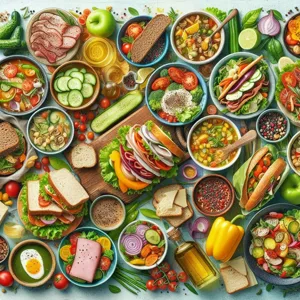Eating well doesn’t have to come with a hefty price tag.
In a world where health and wellness are often associated with expensive organic foods and gourmet ingredients, it’s easy to feel overwhelmed and discouraged. However, nourishing your body with wholesome meals can be both affordable and delicious! In this blog post, we’ll explore ten practical tips to help you craft healthier meals on a budget, proving that eating well is accessible to everyone. From strategic shopping and meal planning to embracing seasonal produce and simple recipes, these actionable insights will empower you to make smarter food choices without sacrificing flavor or your finances. Join us as we embark on a journey to discover how to eat well on a budget and transform the way you view meal prep and grocery shopping!
1. Introduction: The Importance of Eating Well on a Budget

Eating well on a budget is not just a trend; it’s a necessity for many households striving to maintain a healthy lifestyle while managing their finances. In a world where the cost of living continues to rise, making smart food choices becomes increasingly important. Nutrition plays a crucial role in our overall well-being, influencing everything from our energy levels to our immune system. However, many people mistakenly believe that eating healthy requires a lavish budget filled with organic produce and gourmet ingredients. The truth is, with some planning and creativity, you can enjoy a nutritious diet without overspending.
Incorporating wholesome foods into your meals doesn’t have to mean compromising on taste or quality. By understanding the principles of budget-friendly eating, you can learn to make informed choices that nourish your body and your wallet. This journey begins with simple strategies, such as meal planning, shopping smart, and making the most of seasonal produce. Not only will you find that healthy meals can be delicious and satisfying, but you’ll also feel empowered knowing that you’re taking care of your health and finances simultaneously.
As we delve into this guide, we’ll explore ten practical tips that can help you eat well without breaking the bank. Whether you’re a busy parent, a student, or simply looking to stretch your grocery budget, these strategies will set you on the path to healthier meals that enhance your life while keeping your expenses in check. Join us as we discover that nourishing yourself can be both affordable and enjoyable!
2. Plan Your Meals: The Key to Saving Money
Planning your meals is not just a helpful strategy; it’s the cornerstone of eating well on a budget. Taking the time to map out your meals for the week can significantly reduce your grocery bills and help you make healthier choices. Start by dedicating a little time each week to create a meal plan that aligns with your dietary preferences and the ingredients you already have on hand.
Begin with a few staple recipes that you enjoy and can easily rotate throughout the week. Consider incorporating versatile ingredients that can be used in multiple dishes, such as brown rice, beans, and seasonal vegetables. By doing this, you not only cut down on waste but also save money by buying in bulk and utilizing what you have.
Once you have your meals planned, create a detailed grocery list that only includes the items you need. Stick to this list when shopping to resist the temptation of impulse buys, which can quickly add up. Don’t forget to check for sales and promotions at your local grocery store, which can further stretch your budget.
Additionally, planning your meals allows you to prepare larger batches of food that can be stored for later. Cooking in bulk not only saves time but also reduces the likelihood of reaching for unhealthy convenience foods when you’re short on time or energy.
Finally, remember that planning also includes considering how to incorporate leftovers into future meals. This can transform a single cooking session into several satisfying and nutritious meals, ensuring that you get the most out of your grocery budget. By making meal planning a priority, you’ll find that eating well doesn’t have to come at a hefty price. It’s a proactive approach that empowers you to nourish your body and your wallet simultaneously.
3. Create a Shopping List and Stick to It

Creating a shopping list is not just a simple task; it’s a strategic step that can revolutionize your grocery shopping experience and help you eat well on a budget. Before you head out to the store, take a few moments to plan your meals for the week. Think about what ingredients you need for breakfast, lunch, and dinner, and jot them down. By organizing your thoughts, you can avoid the chaos of impulse buys that can quickly add up and derail your budget.
Once you have your list, it’s essential to stick to it. Resist the siren call of those tempting displays and flashy promotions that often catch the eye. Supermarkets are designed to encourage impulse purchases, but with your list in hand, you can navigate the aisles with purpose and focus. This discipline not only helps you stay on track financially but also ensures that you’re purchasing items that will contribute to balanced and nutritious meals.
To further enhance your shopping experience, consider categorizing your list based on the layout of your favorite grocery store. Grouping items by type—such as produce, grains, dairy, and proteins—can save you time and help you avoid backtracking to pick up forgotten items. Additionally, try to include seasonal fruits and vegetables, which tend to be more affordable and fresher.
By committing to a shopping list and sticking to it, you’ll find that it’s easier to manage your grocery budget while still making health-conscious choices. This simple practice not only fosters mindful consumption but also empowers you to take control of your eating habits without sacrificing quality or flavor.
4. Buy in Bulk: Benefits and Tips for Bulk Shopping
Buying in bulk is one of the best strategies to maximize your grocery budget while ensuring you have nutritious options on hand. When you purchase items in larger quantities, not only do you often benefit from lower prices per unit, but you also reduce the frequency of shopping trips, saving both time and money in the long run.
**Benefits of Bulk Buying**
One of the most significant advantages of buying in bulk is the cost savings. staples like rice, pasta, lentils, and oats are usually much cheaper when bought in larger quantities, allowing you to stock up without the guilt of overspending. Additionally, bulk purchases often come with less packaging, making them a more environmentally friendly choice. This not only helps reduce waste but can also be a great conversation starter about sustainable eating habits.
Another benefit is the versatility that comes with having a variety of bulk staples at your disposal. With a well-stocked pantry of grains, legumes, nuts, and spices, you can easily whip up a range of healthy meals, from hearty soups to refreshing salads, without feeling the need to run to the store for missing ingredients.
**Tips for Successful Bulk Shopping**
To make the most of your bulk shopping experience, it’s essential to plan ahead. Start by making a list of items you frequently use and check for sales or promotions at your local bulk food store. Some stores offer membership programs that provide additional discounts on bulk items, so consider signing up if you shop there regularly.
When purchasing perishable goods like fruits, vegetables, or dairy, be mindful of how much you’ll realistically consume before they spoil. Choose items that you can freeze or store effectively, such as bread or cheese, to extend their shelf life.
Lastly, invest in good storage containers. Properly sealing bulk items in airtight containers will keep them fresh longer and prevent pests from invading your stash. Labeling your containers with purchase dates can also help you keep track of freshness, ensuring that nothing goes to waste.
By embracing bulk buying, you can enjoy healthier meals on a budget while significantly reducing your grocery costs and fostering a more sustainable lifestyle.
5. Embrace Seasonal and Local Produce

When it comes to eating well on a budget, embracing seasonal and local produce can be a game-changer. Not only does it allow you to enjoy fresher, tastier fruits and vegetables, but it also saves you money and supports your local farmers. Seasonal produce tends to be more abundant, which often translates into lower prices at farmers’ markets and grocery stores.
As the seasons change, so do the fruits and vegetables available to you. For example, in the summer months, you can relish juicy tomatoes, vibrant bell peppers, and sweet corn, while autumn brings a bounty of hearty squash, crisp apples, and earthy root vegetables. By planning your meals around these seasonal offerings, you can take advantage of their peak flavors and nutritional value, which can enhance your dishes without the need for expensive ingredients.
Additionally, shopping at local farmers’ markets not only ensures fresher produce but also fosters a connection with your community. You may discover unique varieties that you won’t find in conventional grocery stores, sparking creativity in your cooking. Farmers often sell their goods at competitive prices, especially closer to the end of the market day when they prefer to sell out rather than bring items back home.
To make the most of seasonal and local produce, consider crafting a weekly meal plan based on what’s available at your local market. This not only helps in budgeting but also reduces food waste, as you’ll be buying only what you need. Don’t forget to explore preservation methods, such as freezing or canning, to enjoy the flavors of the season even when they are no longer in abundance. By embracing seasonal and local produce, you’ll not only nourish your body with fresh, wholesome ingredients but also cultivate a more sustainable and budget-friendly approach to your meals.
6. Choose Whole Foods Over Processed Items
Choosing whole foods over processed items is one of the most effective strategies for eating well on a budget while also nourishing your body. Whole foods, such as fruits, vegetables, grains, legumes, nuts, and seeds, are typically less expensive per serving than their processed counterparts, which often come with hidden costs—both in terms of your wallet and your health.
When you select whole foods, you’re not just making a financially savvy decision; you’re also choosing ingredients that are rich in vitamins, minerals, and essential nutrients without the added sugars, unhealthy fats, and preservatives that are often found in processed options. For instance, a bag of dried lentils or a sack of brown rice can provide multiple meals for just a few dollars, while a package of pre-made frozen meals may only last one or two servings and contain questionable ingredients.
Moreover, whole foods are incredibly versatile. A simple sweet potato can be roasted, mashed, or turned into fries, giving you a variety of meals from just one ingredient. When shopping, fill your cart with colorful produce and grains that appeal to your taste buds, and don’t shy away from seasonal items, which are often cheaper and at their peak flavor.
Not only will this approach help keep your grocery bill in check, but it will also encourage you to get creative in the kitchen. Cooking from scratch using whole ingredients not only fosters a connection with your food but also allows you to control what goes into your meals. As you embrace whole foods, you’ll likely find yourself feeling more energized and satisfied, all while enjoying the benefits of maintaining a budget-friendly diet. Make the switch today, and watch how your meals—and your health—transform!
7. Meal Prep: How to Save Time and Money

Meal prepping is an invaluable strategy for anyone looking to eat well on a budget. By taking a few hours each week to plan and prepare your meals in advance, you can save both time and money while also ensuring that you eat healthier options throughout the week. The key to successful meal prep lies in organization and creativity, allowing you to make the most of your ingredients.
Start by setting aside a specific day and time for meal prep—perhaps a Sunday afternoon or an evening when you have some downtime. Gather your favorite recipes and create a shopping list based on what you need. This not only helps you avoid impulse purchases at the grocery store but also minimizes food waste, as you’ll be buying exactly what you need for your planned meals.
When you’re ready to cook, choose recipes that share similar ingredients to maximize your purchases. For example, if you buy a bunch of spinach, plan to use it in a salad, a smoothie, and a stir-fry. This strategy not only diversifies your meals but also ensures that none of your ingredients go to waste.
Once your meals are prepared, portion them into containers for easy grab-and-go options during your busy week. This makes it less likely that you’ll resort to expensive takeout or unhealthy snacks when hunger strikes. Plus, having nutritious meals readily available can help you stay on track with your health goals.
Don’t be afraid to get creative with your meal prep! Batch-cook grains like quinoa or brown rice, roast a variety of vegetables, and prepare protein sources such as chicken, beans, or tofu. With a little creativity, you can mix and match throughout the week to keep your meals exciting and flavorful.
By dedicating some time to meal prep, you’ll not only streamline your week but also find that eating well on a budget is entirely possible. With healthier meals at your fingertips, you’ll be empowered to make choices that benefit your body and your wallet.
8. Utilize Coupons and Store Discounts
In the world of grocery shopping, coupons and store discounts are your best friends. These handy tools can significantly reduce your overall food expenses while allowing you to maintain a nutritious diet. To make the most of these savings, start by familiarizing yourself with your local stores’ weekly ads and loyalty programs. Many retailers offer special promotions that can help you snag essentials at a fraction of their regular price.
Consider investing a little time in research—scour online coupon sites, apps, and social media pages for your favorite brands. You’ll often find digital coupons that can be easily loaded onto your store loyalty card, making the redemption process seamless at checkout. Don’t forget to check for printable coupons that you can clip or download directly to your phone.
When planning your meals, try to align your menu with what’s on sale. If chicken is discounted this week, consider whipping up a hearty chicken stir-fry or a comforting chicken soup. Seasonal produce is another area where you can score big savings, as many stores reduce prices on fruits and vegetables that are currently in abundance.
Additionally, keep an eye out for clearance sections in your local grocery store. Items nearing their expiration date can be perfect for meal prepping or freezing for later use. This not only helps you save money but also minimizes food waste.
By utilizing coupons and taking advantage of store discounts, you can stretch your budget further, allowing you to fill your cart with nourishing foods without feeling guilty about overspending. Remember, eating well doesn’t have to come with a hefty price tag—smart shopping can keep your meals healthy and affordable!
9. Cook at Home: Simple Recipes for Healthy Meals
Cooking at home is one of the most effective ways to eat well on a budget, and it doesn’t have to be complicated or time-consuming. In fact, with a little creativity and some basic ingredients, you can whip up delicious, nutritious meals that are both satisfying and wallet-friendly.
Start with simple recipes that require minimal ingredients but pack a punch in flavor and nutrition. For instance, consider a hearty vegetable stir-fry; all you need are some fresh or frozen vegetables, a protein source like tofu or chicken, and a few spices. Toss everything together in a pan, and in under 30 minutes, you have a colorful, vibrant meal that’s high in vitamins and low in cost.
Another great option is one-pot meals, such as soups or stews, which allow you to throw in whatever ingredients you have on hand. These dishes are not only easy to prepare but also perfect for meal prepping. Make a big batch on the weekend and enjoy leftovers throughout the week. A classic lentil soup, for example, can be made with just lentils, broth, and whatever vegetables you have lying around—carrots, onions, or spinach work wonderfully.
Don’t forget the power of grains! Cooking up a batch of brown rice or quinoa can serve as a nutritious base for a variety of meals. Top them with roasted vegetables, beans, or a simple homemade sauce, and you have a filling dish that won’t strain your budget.
Lastly, embrace the art of seasoning. Fresh herbs, spices, and even citrus can elevate a simple dish into something extraordinary without adding significant cost. Try experimenting with different combinations to discover new favorites.
By making the choice to cook at home, you’re not only saving money but also gaining control over the ingredients in your meals, allowing you to prioritize health without sacrificing flavor. So grab your apron, and get ready to explore the delicious world of home cooking!
10. Make the Most of Leftovers: Creative Ideas
In the quest for healthier meals on a budget, one of the most effective strategies is to make the most of your leftovers. Instead of viewing them as mere remnants of your previous meals, think of leftovers as a blank canvas for culinary creativity. By repurposing what you have, you not only reduce food waste but also save time and money, all while enjoying a variety of delicious dishes.
Start by assessing what you have on hand. Leftover roasted vegetables can be transformed into a vibrant stir-fry or tossed into a hearty soup. Cooked grains, like quinoa or brown rice, can serve as the base for a refreshing grain bowl—just add some fresh greens, a protein source like beans or chicken, and a flavorful dressing. Even last night’s pasta can be reinvented; consider mixing it with a new sauce, adding some sautéed greens, or turning it into a comforting baked pasta dish.
Breakfast is another great opportunity to utilize leftovers. For instance, leftover roasted sweet potatoes can be mashed and spread on toast, topped with a poached egg for a filling start to your day. Or, whip up a quick frittata using any remaining vegetables and proteins, which can be sliced and enjoyed throughout the week.
Don’t forget about the power of freezing! If you find yourself with large quantities of food that you can’t consume in a timely manner, freeze them in individual portions. Soups, stews, and sauces often taste even better after being frozen and reheated, allowing you to savor a homemade meal later on when time is tight.
By embracing the art of leftovers, you not only stretch your grocery dollars further, but you also cultivate a mindset of resourcefulness in the kitchen. With a little imagination and a willingness to experiment, those leftover bits and pieces can turn into exciting new meals, ensuring that eating well on a budget becomes not only achievable but enjoyable.
11. Invest in Essential Kitchen Tools
When it comes to eating well on a budget, having the right kitchen tools can make all the difference in your culinary experience. Investing in essential kitchen tools not only simplifies meal preparation but also encourages you to cook at home more often, which is typically healthier and more cost-effective than dining out.
Start with the basics: a sturdy chef’s knife, a cutting board, and a reliable set of pots and pans. A good chef’s knife can drastically cut down on prep time and help you tackle a variety of ingredients with ease. A versatile set of pots and pans—ideally non-stick or stainless steel—allows you to whip up everything from soups and stews to stir-fries and one-pan meals.
Don’t overlook the importance of kitchen gadgets that can make cooking more efficient. A slow cooker or pressure cooker can be a game-changer, allowing you to prepare meals in bulk for the week. With minimal effort, you can create hearty soups, stews, and casseroles that stretch your grocery dollars further. Similarly, investing in quality food storage containers can help you keep leftovers fresh, reducing food waste and enabling you to enjoy healthy meals on the go.
A good blender or food processor can open up a world of culinary possibilities, from smoothies and sauces to homemade dips and spreads. These tools can help you incorporate more fruits and vegetables into your diet, making it easier to eat healthier without spending a fortune.
Lastly, don’t underestimate the power of a digital kitchen scale or measuring cups and spoons. These tools can help you accurately portion your ingredients, making it easier to stick to recipes and avoid overbuying items you may not use, saving you both time and money.
By investing in these essential kitchen tools, you’re not just setting yourself up for success in the kitchen; you’re creating an environment that fosters creativity and healthy eating, all while keeping your budget in check. With the right tools at your disposal, preparing nutritious meals becomes not only manageable but also enjoyable!
12. Learn to Substitute Ingredients for Cost Savings
Mastering the art of ingredient substitution can be a game-changer for anyone looking to eat well on a budget. It not only allows you to save money but also opens up a world of culinary creativity. Instead of feeling tied to a specific recipe, embrace the idea that many ingredients can be swapped for more affordable options without sacrificing flavor or nutrition.
For instance, if a recipe calls for costly cuts of meat, consider using more economical sources of protein like beans, lentils, or even eggs. These alternatives are not only budget-friendly but also packed with essential nutrients. Similarly, fresh herbs can be substituted with dried versions, which are often less expensive and have a longer shelf life.
Vegetables are another area ripe for substitution; if a recipe calls for a specific vegetable that’s out of season or pricey, look for frozen alternatives or use what you already have in your fridge. For example, if a dish calls for asparagus, consider using green beans or broccoli instead. You’ll be surprised at how easily you can adapt recipes to fit your available ingredients.
Moreover, when it comes to dairy products, switching to store-brand items or opting for less expensive versions can lead to significant savings. Plain yogurt can often replace sour cream in recipes, providing a healthier twist along with a more economical choice.
By learning to substitute ingredients mindfully, you empower yourself to create delicious meals that align with your budget. It’s not just about cutting costs; it’s about being resourceful and inventive in the kitchen, making healthy eating accessible and enjoyable for everyone. Embrace the swaps, and watch your grocery bills shrink while your culinary repertoire expands!
13. Growing Your Own Herbs and Vegetables
Growing your own herbs and vegetables is not just a rewarding hobby; it’s also a fantastic way to elevate your meals while keeping costs down. Imagine stepping into your backyard (or even your kitchen) and plucking fresh basil, cilantro, or tomatoes right before you toss them into your dish. The flavors are vibrant and unparalleled, and the satisfaction of knowing you grew them yourself adds an extra layer of joy to your cooking.
Starting a small garden doesn’t require a vast amount of space or a green thumb. Even a few pots on a windowsill can yield a surprising amount of produce. Herbs like parsley, chives, and mint thrive in small containers, while vegetables like lettuce, radishes, and cherry tomatoes can flourish in a sunny corner of your patio. Many of these plants are low-maintenance and grow quickly, allowing you to enjoy the fruits of your labor in no time.
Moreover, home gardening can significantly cut down your grocery bill. Fresh herbs can be surprisingly pricey at the store, and having them at your fingertips not only saves money but also encourages you to experiment with flavors in your cooking. Imagine whipping up a pesto with your homegrown basil or adding a sprinkle of freshly cut thyme to roasted vegetables—these simple additions can transform ordinary meals into culinary delights.
Additionally, growing your own produce allows you to control the quality of what you consume. You can opt for organic gardening practices, ensuring that your food is free from harmful pesticides and chemicals. Plus, gardening can be a therapeutic activity, providing a wonderful escape from the hustle and bustle of daily life.
So, whether you have a sprawling garden or just a few pots on your balcony, consider growing your own herbs and vegetables. It’s a small investment of time and effort that can yield delicious, healthy meals at a fraction of the cost. With each harvest, you’ll not only nourish your body but also cultivate a deeper connection to the food you eat.
14. Explore Affordable Protein Sources
When it comes to maintaining a healthy diet on a budget, protein can often be one of the more expensive components of a meal. However, exploring affordable protein sources opens up a world of culinary possibilities without straining your wallet. Instead of defaulting to pricier cuts of meat or expensive seafood, consider incorporating a variety of more economical options that not only keep your meals nourishing but also delightful.
Start with eggs, a versatile powerhouse that can be scrambled, poached, or made into an omelet, providing a high-quality protein source at a fraction of the cost. Canned fish, such as tuna or salmon, is another budget-friendly alternative; packed with omega-3 fatty acids and full of flavor, these can be easily tossed into salads, pasta dishes, or sandwiches for a quick protein boost.
Legumes, including lentils, chickpeas, and black beans, are not only affordable but also rich in fiber and nutrients. They can be transformed into hearty soups, stews, or even veggie burgers, making them an excellent staple for any budget-conscious kitchen. Additionally, consider incorporating tofu or tempeh, which are both excellent sources of plant-based protein and can absorb the flavors of your favorite spices and sauces, enhancing any dish.
Don’t overlook the power of grains as well; quinoa and farro, while slightly more expensive than rice or pasta, can add a nutritious punch to your meals. By experimenting with these affordable protein sources, you’ll find that eating well doesn’t have to mean sacrificing flavor or breaking the bank. Your health, taste buds, and wallet will thank you!
15. Conclusion: Balancing Nutrition and Budgeting for a Healthier Lifestyle
In conclusion, embracing a healthier lifestyle while staying within a budget is not only achievable but can also be a rewarding challenge. By implementing the tips we’ve discussed, you can create nutritious meals that nourish your body and satisfy your taste buds without straining your wallet.
Start by planning your meals and making a shopping list to avoid impulsive purchases, and be mindful of seasonal produce, which can offer both freshness and savings. Don’t shy away from bulk buying—staples like grains, legumes, and nuts not only stretch your dollar but also form the foundation of many wholesome meals.
Experimenting with cooking methods and exploring new recipes can keep your meals exciting and reduce reliance on costly pre-packaged foods. Remember, it’s about making smart choices rather than sacrificing taste for price.
As you embark on this journey, keep in mind that eating well is a long-term commitment. Celebrate small victories, and don’t be discouraged by occasional splurges. With creativity, patience, and a little planning, balancing nutrition and budgeting will become a seamless part of your daily routine. Prioritize your health without the worry of overspending, and enjoy the delicious and diverse world of affordable, wholesome food. Your body—and your bank account—will thank you!




































